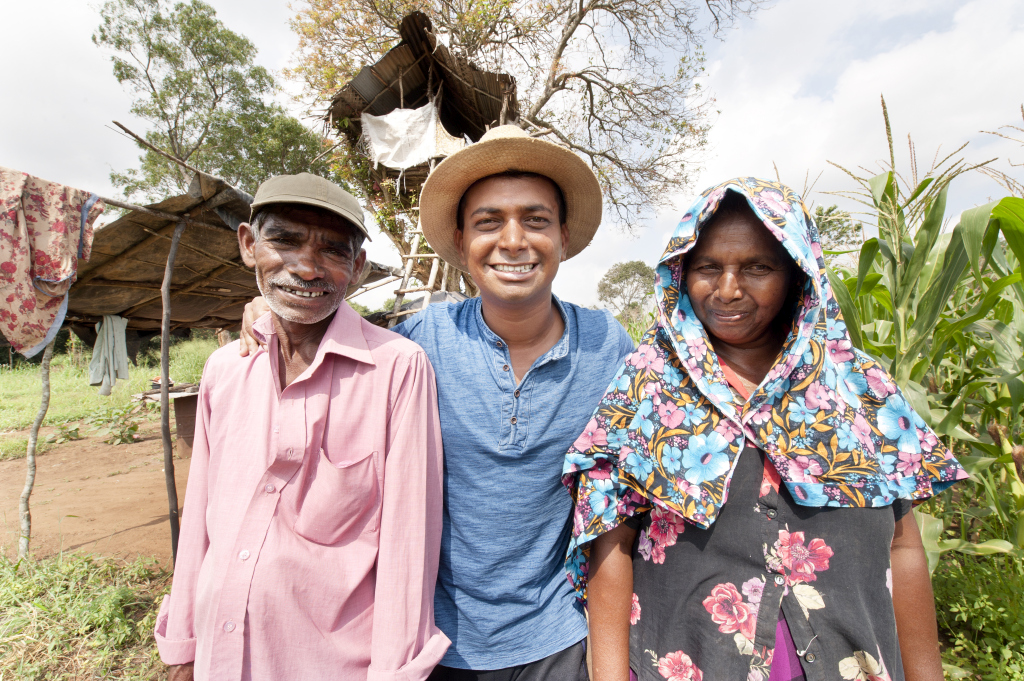Except for the towering wind turbines, Navatkadu looks at first glance like any other village along Sri Lanka’s western coast, with clusters of shops and homes scattered along the busy main road. Not until you turn onto one of its side streets and proceed past the brightly colored church, do you start to realize what else sets this and nearby villages apart. It’s not just the wind farm above but the ultra-intensive farming of cash crops below.
An intricate patchwork of small plots – planted with chilli, cabbage, beetroot, and tobacco – stretches into the distance. The morning sunlight glistens on water sprayed from locally made sprinkler irrigation systems installed in almost every plot. The sputtering of dozens of small motors pumping groundwater through underground networks of pipes fills the air.
The 400 farm families who cultivate these fields, along with their hired laborers, waste no space and no time. The plots are separated only by narrow dirt roads and strips of grass, with rows of coconut trees. In all directions, men and women are frantically busy. A young woman briskly walks the length of one plot, opening irrigation valves in quick succession. Nearby, a mother-and-grown-son team irrigate their chilli crop using a black hose, which they move carefully from one furrow to the next.
This is agriculture on steroids. To keep up the pace depends on a huge collective effort but also on one man’s unceasing quest for efficiency. During a break from helping load a small truck with plastic crates carefully packed with produce, M.L. Jesus explains how his and other villages in the Kalpitiya peninsula created their remarkably productive and profitable agribusiness.
On fertile land around the village church, his grandfather’s generation began growing small plots of vegetables in the dry season, irrigating them laboriously by hand with pots of water from the village well. In the last 15 years, farmers have expanded the area under cultivation to about 500 hectares by investing in tubewells and motor pumps. In response to rising labor costs (driven in part by competition with Kalpitiya’s burgeoning tourism), farmers have recently adopted sprinkler irrigation systems. The porous sandy soils obligate them to irrigate frequently and apply fertilizers, while also using agrochemicals to control pests and diseases.
“Jesus, who has a diploma in agriculture, pioneered the technological changes in this region,” says Mohamed Aheeyar, a researcher with the International Water Management Institute (IWMI) and first author of a new case study (IWMI Working Paper 188) analyzing the spread of motor pumps for irrigation in Sri Lanka. “These farmers’ achievement, on a cropped area of about 6,000 hectares in nearly 20 villages, is one especially striking example of a wider phenomenon that is unfolding across the country’s Dry Zone.”
More typical, perhaps, is the experience of farmers living in Thirappane and Medawachchiya Divisional Secretariat, an hour or more away, around Anuradhapura, Sri Lanka’s ancient capital. This whole region is dotted with village reservoirs, forming part of so-called “cascade tank” systems that date back centuries.
Disabled army veteran Priyantha Kumara and his neighbors grow rice in the monsoon season for household consumption, relying on the village reservoir for irrigation. To boost the family’s cash income, Priyantha, his wife, mother and father have invested about USD 1,500 to dig a 5-meter-wide “agro-well” just outside the village and buy a motor pump. Previously, they sowed millet and sesame on this fertile upland but harvested little because of unreliable rainfall. Now, they earn a steady income in the dry season by producing melon, maize, long bean, chilli, onion and cabbage irrigated with groundwater.

The IWMI study traces the rapid rise of motor pumps – from 100,000 to 275,000 duing the period 2000-2016 – documenting the benefits, while also calling attention to the shortcomings and perils, and suggesting ways to address these.
Smallholder investment in agro-wells and pumps, with government assistance, has enabled many farmers to diversify and intensify their production beyond dependence on subsistence rice farming. These changes, in turn, have raised household incomes, created employment for landless farm workers and offered new opportunities for women to participate in agriculture. Extra income for women has translated into better family well-being but at a high cost in terms of extra demands on their time and labor. Many farmers have missed out on the bonanza for lack of capital.
Agricultural transformation poses other challenges as well. In Kalpitiya, for example, intensive production dependent on irrigation from shallow aquifers in sandy soil and on heavy use of agrochemicals has caused water quality to deteriorate, a problem that is further complicated by the threat of saltwater intrusion.
How then to spread the benefits of groundwater irrigation and reduce its perils? The IWMI study suggests several options. One is to make wells and irrigation equipment more accessible through targeted subsidies and easier access to credit. Another consists of regulatory systems, with standards for well construction and groundwater extraction. Finally, the authors emphasize the need for local groundwater governance. “Farmer organizations have a vital role to play in wise management of groundwater, says Aheeyar. “Their future depends on it.”
Read the report:
Mechanizing water lifting through pumps: a case study in Sri Lanka.

